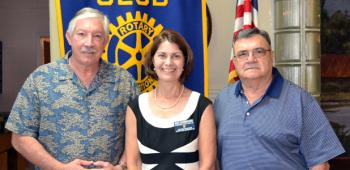
William Thibodeaux, left, presented to the Rotary Club of Crowley Tuesday a history of the formation of Acadia Parish. Welcoming him were, from left, President Mary Zaunbrecher and program organizer Ken Goss.
Rotarians get crash course in Acadia Parish history
Jeannine LeJeune is the online editor for the Crowley Post-Signal. She can be reached at jeannine.lejeune@crowleytoday.com or 337-783-3450.
In anything political, a bit of shadiness and tawdriness can always be found if you look deep enough.
Why should the birth of Acadia Parish be any different?
The Rotary Club of Crowley’s Tuesday meeting featured William Thibodeaux as its guest speaker and the historian presented a program on the early years and formation of Acadia Parish. Of course, Acadia’s origins can be traced back to a blaze of glory, at least from Acadia’s perspective.
Acadia Parish was once a part of St. Landry Parish, but a fire at the parish’s courthouse set forth a chain reaction that led to the formation of Acadia.
The fire itself continues to be cloaked in mystery some 128 years later as a reward, $500, for information on the suspected arson never was awarded and neither was a subsequent reward, $250, to anyone who could prove the fire was accidental, according to Thibodeaux.
But, as time would have it, the creation of Acadia Parish was underway and Rayne, the proposed parish’s center of commerce at the time, was the foregone favorite to be the parish seat.
It took less than a year for all of that to change, however.
The movements began April 3, 1886, when a mass meeting was held in Rayne concerning the formation of the new parish and Rayne’s potential as a parish seat.
The timing for Acadia could not have been more perfect as Thibodeaux pointed out, as 1886 was a Legislative year. In those many years ago, the State Legislature would only meet every other year, thus, if Acadia could not have been proposed and formed in 1886, it would have had to wait until 1888.
It all went off, relatively, without a hitch as in May 1886, a bill was introduced to create the parish of Nicholls, as it was proposed initially. The name, obviously, did not stick and was later changed via an act to create the parish of Acadia.
The bill passed in June in both the house and senate and was signed and approved by Gov. Samuel McEnery at the end of June 1886.
But the politicking was already in motion locally.
First, 19 Opelousas businessmen who attended the April meeting were later found out to be protesting in Baton Rouge. While Rayne was assured the protest was not about the formation of the parish and/or Rayne being the parish seat, many were wary of the story that the 19 were protesting boundary lines of the parish.
Second, a newspaper war grew in Rayne as W.W. Duson bought the Rayne Signal in September and the Rayne Signal and Rayne Sentinel entered into a feud that would last until Duson would move the paper to Crowley in 1888.
Third, lobbying for the parish seat took many different turns. For starters Eugene Hockaday of Prairie Hays (now known as the Church Point area) offered $10,000 and 80 acres of land to build the parish courthouse within a mile of his home.
But that was cast aside and was nothing compared to the ongoing friction between Rayne and a quickly growing area to the west that would become known as Crowley, Thibodeaux explained.
Fourth, construction began in Crowley Jan. 4, 1887, and property was bought and built upon rapidly in the area. According to Thibodeaux, there were stories of the city picking up people from all along the railroad lines and shipping them to Crowley for land purchasing days.
There is also the story of how Crowley got its train depot, which was apparently boxed up from Estherwood and moved east. At the time, it was the largest item ever moved by railcar.
All of these factors combined began making Rayne citizens nervous over the coming parish seat election and it fell to the Rayne Sentinel to quell the fears of the masses.
Fifth, Election Day was moved to March 1 in order to make sure everyone had the opportunity to register to vote. During that election, Crowley was voted as the parish seat by earning 39 percent of the vote. Rayne finished second with 32 percent.
Thibodeaux explained that Acadia’s story and Rayne’s issues do not end there, however.
Ten days after the election, a new town popped up for construction, Hutchinson, situated 4 miles east of Rayne. The sole purpose of the excursion appeared to be to draw commerce away from Rayne. A train depot and siding were quickly built and then building of the area went dormant.
And, about that fire clouded in mystery? Thibodeaux pointed to an interview Duson did with the Crowley paper. Asked where the idea for Crowley came from, Duson said it came to him “about four months” prior to the St. Landry Parish Courthouse fire.
- Log in to post comments
